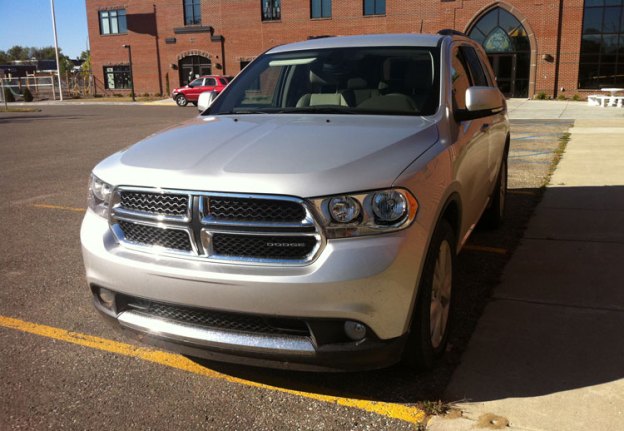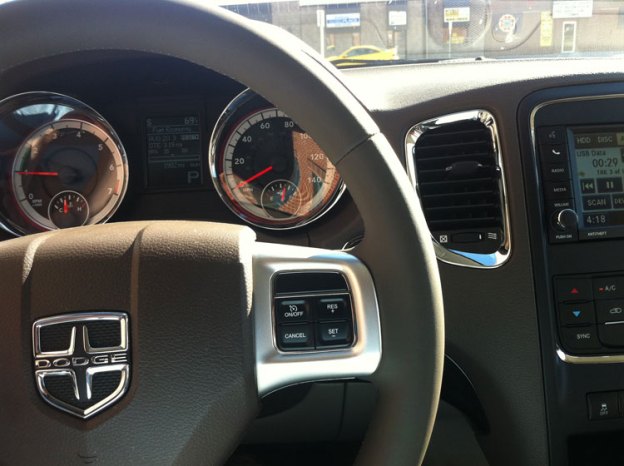
Like a MacBook Air on four wheels, the Dodge Durango Crew is a unibody wonder for those who appreciate sleek styling and creature comforts. Redesigned for the modern age of better fuel economy and sleek transport devices, the 2011 model – which is all new for this year after a brief one-year hiatus – is built on the same platform as the Jeep Cherokee instead of the Dodge Dakota (now Ram Dakota). For those familiar with how the Cherokee drives, the Durango felt quite similar. Yet, this is an SUV that emphasizes style over sheer mud-slinging brawn.
And believe us when we tell you: we tried to sling some mud. Over the course of several days, we drove the Durango on a wet farm road – the same one where we tested the Jeep Cherokee and Ford Explorer in winter, and several recent HD trucks like the Ram Laramie Longhorn HD 2500.

The Durango Crew we tested does not have a dedicated 4×4 mode, so in some ways, this SUV with a third-row seat has more in common with the 2011 Chevy Traverse. At first glance, the Durango looks like a vehicle an attorney would drive: The single-body construction is sleek and angular, with a slight hint of a minivan’s elongated look (at least, the recent models from Chrysler, Honda, and Toyota). Our silver model really did remind us of a MacBook Air – the wrap-around shell, the glimmering silver.
Out on the road, the Durango drove more like a car than a truck, with tight steering compared to previous models and excellent cornering control despite its almost obnoxious weight of nearly 5,000 pounds (or about 300 pounds heavier than the Ford Explorer).
On the farm road, the new Durango held its own. There was no side-to-side swaying as we experienced with a couple of Nissan models last spring. The Durango uses a 50-50 split differential AWD that lacks the adaptive intelligence of the Ford Explorer, or the ability to adjust for specific road conditions. Wheels started slipping, and the Durango just powered through the mud almost by sheer will. On a gravel road, the Durango felt sure and solid, mostly due to the front and rear differentials.

Our Durango had a 3.7-liter V6 with 290-horsepower and 260-lb-ft of torque. There’s also a premium version of the Durango that comes with a 360-horsepower V8. The V6 version we tested delivered about 20 miles per gallon – it’s rated for 23 highway. Towing capacity on the V8 model is best in class at 7,400 pounds. Oddly, the Durango has a five-speed automatic transmission that tended to lurch and drag a bit in the upper gears, although most people won’t drive it pell-mell on a farm road or take corners at 75mph.
Inside, it’s all about luxury appointments. We liked the tone and styling of the interior better than the Ford Explorer, which just has a bit of a tough-guy aesthetic. The Durango interior seems like it is designed to work well when you step out of the driver’s seat at a Las Vegas casino. The only really muscular component inside is the floor-mounted shifter, which is big and bulky.
In the center stack, there’s a button for enabling the rear passenger two-prong power outlet, and one that flips down the third-row head rests in prep for folding them down. You can connect up your iPhone using the USB port, or stream over Bluetooth. We had no problems with audio playback, and even tested out a USB thumb drive loaded with a collection of WAV and MP3 files, and they all played fine.

There wasn’t an LCD screen for the second-row passengers, but the touchscreen in front looked bright and clear. Also, in the Crew version we tested, there’s no sunroof – a slight disappointment. Rear seating is extremely wide and comfortable, even in the far back – the third row is not just for kids. The middle seats fold up easily, and the third row seats flip forward. There’s almost 85 cubic inches of space with all rear seats folded down, which is a bit less than other SUVs in this model year.
So, what’s the real story here, compared to the Explorer and Traverse? We think the Durango fits somewhere in the middle. The Explorer has a beefier drive that plows over snow banks and dirt piles – you can adjust the settings for current road conditions. We remember driving the Explorer on a thick sheet of ice for about 90 miles, and we’re not sure how the Durango would fare. The Traverse drove more like a car and was even less convincing as a true SUV that won’t get stuck in mud, but several passengers also commented on how smooth the ride felt. Meanwhile, the Jeep Cherokee had a better stereo and, like the Explorer, has settings for particular road conditions.
The Durango offers a comfortable ride, the steering is tighter, and the exterior styling is definitely more modern. You might buy the Durango, at $33,420, to impress a client, but you’d want the Explorer if you and the client were going to drive in a sand pit or over a glacier lake in winter. No other SUV quite has the elegant appeal of the Durango, though, and that counts for some serious cred.
Editors' Recommendations
- 2024 Dodge Charger Daytona reinvents the muscle car for the EV era
- This 717-horsepower Dodge Charger is the ultimate family sedan


